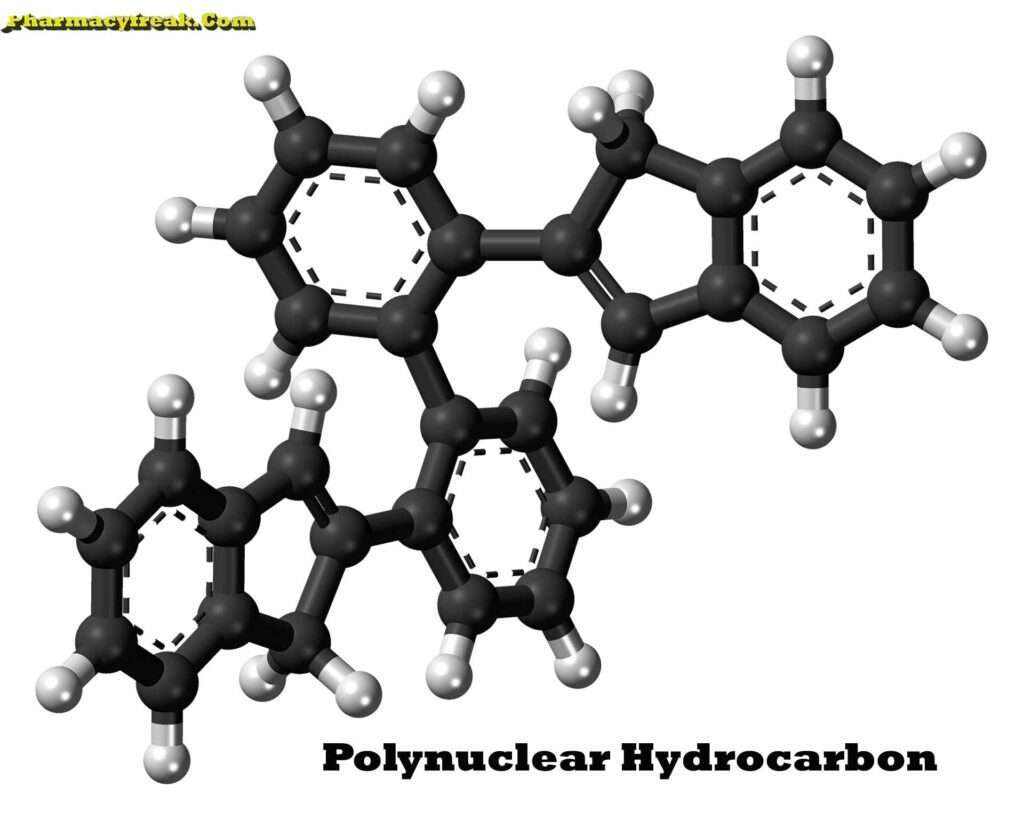
MULTIPLE CHOICE QUESTION of Polynuclear Hydrocarbons of Pharmaceutical Organic Chemistry 3rd semester B.Pharmacy
1. In aromatic hydrocarbons they have
- a) Only sigma bonds
- b) Only pi bonds
- c) a sigma and delocalized pi bond
- d) a sigma and two pi bond
Answer- c) a sigma and delocalized pi bond
2. Which among these is the simplest example for polynuclear hydrocarbon?
a) Pyrene
- b) Dibenzoanthracene
- c) Naphthalene
- d) Benzacephenanthyrlene
Answer- c) Naphthalene
3. The main sources of polynuclear hydrocarbons are
- a) Biogas and petroleum
- b) Natural gas
- c) Petroleum
- d) Coal tar and petroleum
Answer- d) Coal tar and petroleum
4. Phenanthrene is a fused polycyclic compound contains
- a) Three benzene rings
- b) Four benzene rings
- c) Two benzene rings
- d) Four benzene rings
Answer- a) Three benzene rings
5. As compare to benzene, Naphthalene is
- a) More reactive and more aromatic
- b) More reactive and less aromatic
- c) Less reactive and less aromatic
- d) Less reactive and more aromatic
Answer- b) More reactive and less aromatic
6. Naphthalene on reaction with H/Ni gives
- a) Cis decalin
- b) Trans decalin
- c) Cis tetralin
- d) Trans tetralin
Answer- b) Trans decalin
7. Which is fused cyclic aromatic compound?
- a) Biphenyl
- b) Diphenyl methane
- c) Diphenylamine
- d) Naphthalene
Answer- d) Naphthalene
8. In Friedel crafts alkylation AICI3 is used to generate
- a) Strong nucleophile
- b) Strong electrophile
- c) Weak nucleophile
- d) Weak electrophile
Answer- b) Strong electrophile
9. Naphthalene on oxidation with KMnO4 in acidic medium gives
- a) Phthaldehyde
- b) Phthalic anhydride
- c) Phthalic acid
- d) Phthalonic acid
Answer- c) Phthalic acid
10. Electrophile attack on naphthalene at
- a) C1
- b) C3
- c) C2
- d) C4
Answer- a) C1
11. In addition reaction of naphthalene all atoms of bromine and chlorine add on
- a) Same ring
- b) Other ring
- c) Both the ring
- d) None of above
Answer- a) Same ring
12. In Friedel crafts acylation of naphthalene use of non polar solvent gives
- a) 1-substituted product
- b) 2-substituted product
- c) 3-substituted product
- d) 4-substituted product
Answer- a) 1-substituted product
13. On sulphonation of naphthalene at 165°C it gives
- a) 1-Naphthalene sulfonic acid
- b) 2-Naphthalene sulfonic acid
- c) 3-Naphthalene sulfonic acid
- d) 1 and 2-Naphthalene sulfonic acid
Answer- b) 2-Naphthalene sulfonic acid
14 .All carbon atoms in anthracene are
- a) sp hybridized
- b) sp² hybridized
- c) sp³ hybridized
- d) None of above
Answer- b) sp² hybridized
15. 1-Nitronaphthalene on reduction yields
- a) 1-Naphthylamine
- b) 2-Naphthylamine
- c) 1-Naphthol
- d) 2-Naphthol
Answer- a) 1-Naphthylamine
16. What happens when two molecules of benzyl chloride condensed in presence of AICl3
- a) Naphthalene is formed
- b) Phenanthrene is formed
- c) Anthracene is formed
- d) None of above
Answer- c) Anthracene is formed
17. In polar solvent Friedel-Crafts acylation in anthracene occurs at-.
- a) C9 position
- b) C2 position
- c) C4 position
- d) C1 position
Answer- d) C1 position
18. Anthracene on oxidation with Na2Cr2O7 to give
- a) Phthalic acid
- b) Benzoic acid
- c) Anthraquinone
- d) Benzophenone
Answer- c) Anthraquinone
19. Anthracene undergoes electrophillic substitution reactions mainly at
- a) C-1
- b) C-9
- c) C-2
- d) C-4
Answer- b) C-9
20. Sulfonation on anthracene with excess H2SO4 to give-
- a) 1,2 and 2,7 sulfonic acid
- b) 1,8 and 2,7 sulfonic acid
- c) 1,2 and 2,9 sulfonic acid
- d) 1,8 and 2,9 sulfonic acid
Answer- b) 1,8 and 2,7 sulfonic acid
21. Anthraquinone on reduction with Zn dust in aq. NH,OH yields
- a) Anthraquinol
- b) Bianthryl
- c) Anthrone
- d) 9,10-dihydroanthrol
Answer- d) 9,10-dihydroanthrol
22. Anthraquinone on heating with oleum at 160°C gives
- a) 1-sulfonic acid
- b) 2-sulfonic acid
- c) 6-sulfonic acid
- d) 7-sulfonic acid
Answer- b) 2-sulfonic acid
23. Phenanthrene on reduction gives
- a) Diphenic acid
- b) 9,10-phenanthraquinone
- c) 9,10-dihydrophenanthrene
- d) Diphenyl aldehyde
Answer- c) 9,10-dihydrophenanthrene
24. On ozonolysis of phenanthrene, it gives
- a) Phenanthraquinone
- b) Diphenic acid
- c) Phenanthranic acid
- d) Diphenylaldehyde
Answer- d) Diphenylaldehyde
25. Phenanthraquinone on oxidation with Na₂Cr₂O, yields
- a) Diphenic acid
- b) Phenanthrene
- c) Diphenyl aldehyde
- d) None of above
Answer- a) Diphenic acid
26. Oxidation of Diphenyl methane with chronic acid yields
- a) Acetophenone
- b) Benzophenone
- c) Fluorene
- d) Triphenylmethane
Answer- b) Benzophenone
27. Benzene on reaction with chloroform or carbon tetrachloride in presence of AICI, gives
- a) Diphenylmethane
- b) Triphenylmethane
- c) Both (a) and (b)
- d) None of above
Answer- b) Triphenylmethane